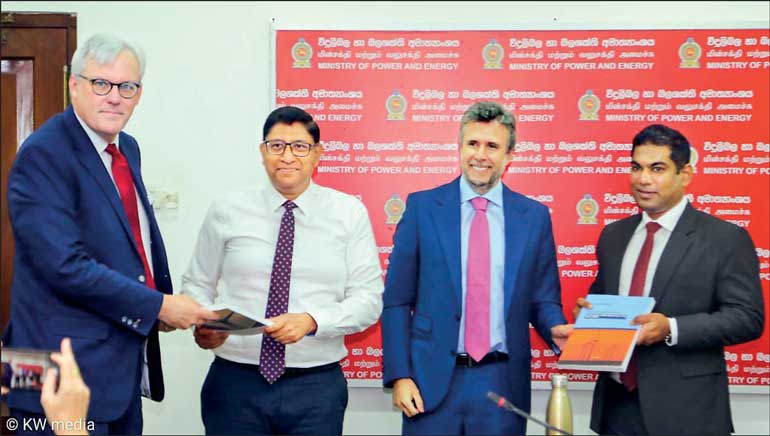Friday Dec 05, 2025
Friday Dec 05, 2025
Saturday, 26 August 2023 00:09 - - {{hitsCtrl.values.hits}}

Power and Energy Minister Kanchana Wijesekera (right) with the copy of the “Offshore wind roadmap for Sri Lanka” presented by IFC Country Manager Alejandro Alvarez de la Campa yesterday whilst new UK High Commissioner Andrew Patrick received a copy from World Bank Acting Country Manager Asela Dissanayake
The roadmap for offshore wind for Sri Lanka was unveiled yesterday by the World Bank Group to guide the country to benefit from this vast natural resource.
The roadmap provides strategic analysis of the offshore wind development potential in Sri Lanka, considering the opportunities and challenges under different offshore wind growth scenarios. It is intended to provide evidence to support the Government in establishing policy, regulations, processes, and infrastructure to successfully deploy offshore wind.
According to the report, Sri Lanka has good natural conditions for offshore wind and there is already private sector interest in developing projects. It emphasised that Sri Lanka has an opportunity to use this domestic renewable energy resource as part of its transition to net-zero carbon and to help reduce the economic burden from fossil fuel imports.
The roadmap report was initiated by the World Bank Group under its Offshore Wind Development Program, which aims to accelerate offshore wind development in emerging markets. The roadmap was funded by the Energy Sector Management Assistance Program (ESMAP) with support from the World Bank’s blue economy program, PROBLUE. It was prepared under contract to the World Bank, by COWI in association with Lanka Hydraulic Institute, EML Consultants, and The Biodiversity Consultancy (TBC).
The roadmap was presented to Power and Energy Minister Kanchana Wijesekera yesterday.
“Sri Lanka aims to have 70% of our electricity generated from renewable sources by 2030 and achieve carbon neutrality by 2050. At the same time, electricity demand is growing and the current dependence on imported hydrocarbon fuels is a risk to our security and cost of supply. As a clean, domestic, and large-scale energy source, offshore wind could help to decrease our carbon emissions while reducing the fuel import bill, increasing security of supply, and supporting the economic development of the country,” Minister Wijesekera said at the launch.
The British High Commissioner to Sri Lanka Andrew Patrick attended the occasion, underscoring the collaborative and international nature of the endeavour. Representatives from the High Commission, prominent country heads, and officials from the World Bank, IFC, and State institutions were also present, signifying the broad spectrum of stakeholders committed to this pioneering initiative.
World Bank Acting Country Manager Asela Dissanayake said as Sri Lanka continues to recover from an economic crisis, it is more important than ever to look towards the future and find solutions that can support sustainable development.
“Over the lifetime of a 500 MW offshore wind farm, the Sri Lankan economy could benefit from over $ 570 million of gross value added. Not only this, but offshore wind could help reduce dependence on imported fossil fuels, alleviating a currently large burden on its foreign reserves and reducing the trade imbalance,” he added.
IFC Country Manager Alejandro Alvarez de la Campa said: “Sri Lanka has good natural conditions for offshore wind and has a great opportunity to use this domestic renewable energy source as part of the country’s goals on transitioning to net-zero carbon. We believe that the energy sector has a significant role in enhancing sustainable development, and as a co-lead of the ‘Offshore Wind Roadmap for Sri Lanka,’ IFC is committed to helping Sri Lanka build a green and resilient power sector”.
The Offshore Wind Roadmap for Sri Lanka analyses the offshore wind development potential in the country under different scenarios to help the government put in place relevant policies, regulations, processes and infrastructure.
The roadmap also recommends that Sri Lanka fosters regional cooperation with India, another emerging offshore wind market. Considering that the short and medium term trajectory for offshore wind in Sri Lanka is relatively modest, combining the opportunity with India’s growing offshore wind market could help attract more industry and supply chain investment. This could help reduce the costs of projects in both countries and increase local economic benefits in Sri Lanka.
It said Sri Lanka continues to recover from an economic crisis, it is more important than ever to look towards the future and find solutions that can support sustainable development.
Under the roadmap’s high growth scenario, consider a more optimistic deployment plan with 1 GW of offshore wind installed capacity by 2030. This would contribute 10% of the country’s power generation capacity and help to avoid up to 2 million metric tonnes of annual CO2 emissions. By 2040, the installed capacity could grow to 2.5 GW and then to 4 GW by 2050.
Under the roadmap’s low growth scenario, analysis shows that Sri Lanka could install 0.5 GW of offshore wind capacity by 2030, contributing 5% of the country’s power generation capacity and helping to avoid up to 1 million metric tonnes of annual CO2 emissions. By 2040, the installed capacity could grow to 1 GW and then to 2 GW by 2050.
“We are committed to continue exploring and building the foundations for offshore wind deployment in Sri Lanka, and this roadmap will be an important guide for us as we embark on this journey. We look forward to continuing working closely with the World Bank Group as we take these next steps in deploying offshore wind,” Power and Energy Ministry Secretary M.P.D.U.K. Mapa Pathirana said.